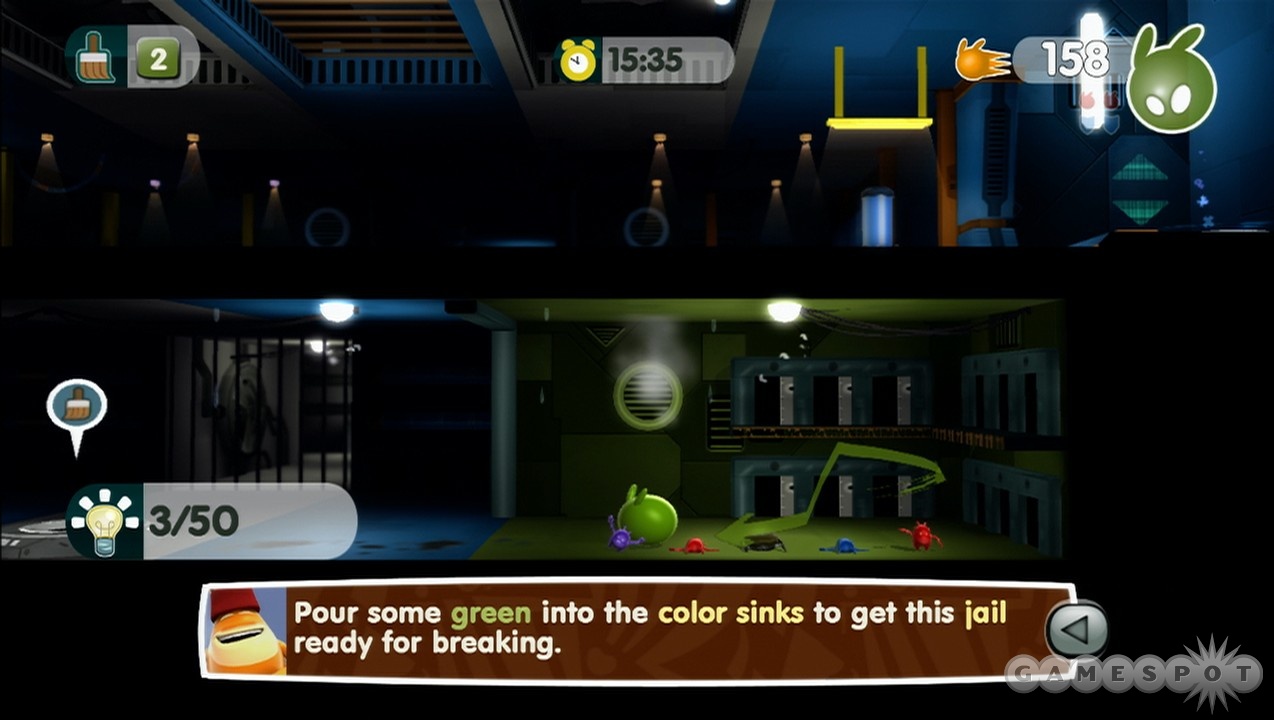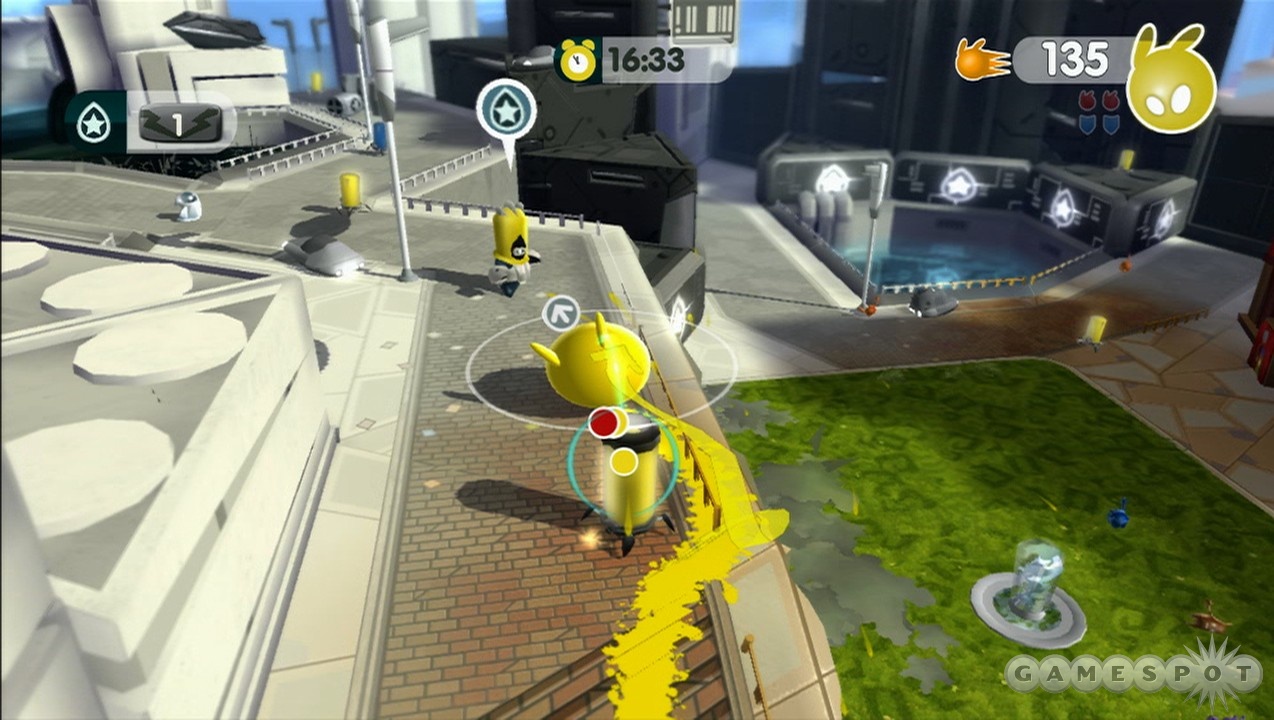The blob known as Blob made his debut in de Blob when it landed on the Wii in 2008, introducing the world to a funky new hero whose ability to absorb color and spread it around was put to great use in that charming platformer. Now, Blob is back, but while fostering political revolution through paint is as intrinsically enjoyable as ever, a nasty tendency to punish you severely for failure and a few other issues prevent this outing from being as enjoyable as the first.
With the help of his friends in the Color Underground, Blob overthrew the oppressive, conformity-enforcing INKT Corporation and unceremoniously evicted Comrade Black from Chroma City. But hatred and poor taste in civic design are not so easily defeated, and Comrade Black has started building a new regime in Prisma City, rigging elections and brainwashing citizens into lifeless, colorless drones. Blob and his fellow revolutionaries once again set out to bring color back to those who find themselves under Black's monochromatic rule. As in the first game, the story is told through a series of great cutscenes that mix humor and seriousness in their portrayal of political oppression and revolution in this cartoon world. De Blob 2 has serious issues on its mind, as is apparent when a lone citizen stands blocking a row of tanks, or when biting comments like "Comrade Black asserts that inkboarding is not torture" run across the news ticker at the bottom of the screen. These weighty real-world concerns lend the game meaning, while the comedic moments, and the game's joyful visuals and sound, ensure that they never overwhelm the experience. Above all else, de Blob 2 is a celebration of color and freedom.
Blob's weapon in the battle against oppression is color. The once vibrant buildings of Prisma City have all become dull under Comrade Black's rule, and the once colorful and diverse populace of Raydians are now sad, homogeneous Graydians. As Blob, your goals typically involve traveling around the levels, restoring color to the buildings and citizens. Once he has absorbed some paint, color flows naturally from Blob; just touching a building is enough to coat the entire structure, and just tapping a billboard can change it from a bland piece of political propaganda into a colorful celebration of people power. Sometimes, you're required to paint buildings specific colors, which can require a little thought. For instance, if you need to paint the sides of some buildings orange but have to paint the surface that you need to stand on to reach those sides red, you have to paint the orange sides first. And you may need to figure out how to make use of the provided paint-carrying robots called paintbots to coat Blob with the colors you require. (Soaking in a pool of blue and then stomping a red paintbot makes Blob purple, for example.) These challenges are never too tough to work out, but they do require you to think for a moment about how to approach a situation.
Blob's touch brings life in other ways, too. Touch a barren tree, and leaves sprout from it; bop a parked vehicle, and it sputters on and takes happily to the skies. Seeing color and life return to the environments thanks to your actions is gratifying, and it's made all the more rewarding by the way the music gradually becomes more lively too. Each time you paint something, a happy little flourish in the music acknowledges your actions, and as the environment becomes increasingly colorful, the music builds up, starting out as little more than a groovy beat and eventually exploding into a full-bodied funky tune. De Blob 2's visuals aren't technically impressive, but they have a charming and very distinct style that makes the colorful environments of Prisma City immensely inviting. Restoring color to this world just feels good.
Unfortunately, the level design doesn't always support this joyous act. Some levels whisk you from one gray area to the next so quickly that you have no time to bask in the color and cheer you've spread. And some, like a level in which you climb one similar tower after another after another, are too repetitive to stay enjoyable. Each of the 12 levels is frequently broken up by side-scrolling sections, which means that you're never doing the same thing for too long. But many of these sections are too simple and too similar to each other to be engaging. You go down a hallway, hit a switch, go down another hallway, hit another switch, maybe stomp out some Inkies, and then return to the surface, having transformed the grim Inky structure into a bopping party palace from the inside. Later in the game, some elements are introduced that make these side-scrolling sections a bit more varied, such as switches that reverse the pull of gravity and a power-up that makes Blob metallic and lets you roll up and down the magnetized rear walls of certain sections. But it takes a bit too long for these elements to be introduced, and when they are, they're not used frequently enough to shake off the feeling of sameness that many of these sections have throughout the game.

Controlling Blob is fun, thanks to responsive controls and a mostly great targeting ability that lets Blob stomp switches, enemies, paintbots, and the like with unerring accuracy. Holding down a trigger targets the nearest targetable object, and the jump button sends Blob crashing down on top of it. This technique can also be used to jump greater distances than you otherwise could. If there's something you can target on the other side of a leap, you can jump for it and then target the object when you get near enough, at which point you can jump again in midair, homing in on the targeted object. Combat is simple but enjoyable. By targeting the Inkies, Blob can stomp out or charge through just about anything they throw at him, provided he has the paint points. Paint points indicate just how much color Blob has stored up in his round, absorbent body, and they can be replenished by stomping paintbots or by taking a quick soak in a pool of paint. Most groups of enemies can be stomped out by just holding down the targeting trigger and mashing on the jump button until the Inkies are no more, and since Blob's movements mirror your button presses, there's a gleeful sense of power that accompanies pounding the Inkies into nothingness.
Unfortunately, when there is any whiff of challenge in combat, it often stems more from the targeting system than from anything your enemies are doing. As you progress, more Inky types sprout up to hinder you, and some need to be tackled in a certain way. Spikeys, for instance, need to be charged rather than stomped, on account of the nasty spike on their helmets. Other Inkies can be stomped out only when Blob's color matches their own. The problem stems from the fact that Blob isn't smart about what he targets. Blob always targets the closest targetable object, even if it's an explosive barrel that you absolutely don't want to stomp. You can switch targets with the right thumbstick, but when you've got enemies on all sides of you, as you often do, selecting the enemies you wish to stomp in the heat of battle can be a bit tricky. Blob may often end up futilely trying to stomp an Elite Inky when there's a Heavy Inky right there that he could stomp without any problem. And focusing on cycling through enemies until your desired target is selected can leave you vulnerable to attack.
De Blob 2 isn't a hard game, but it can nonetheless be a very frustrating one, because when you do fail, the punishment is often severe. Checkpoints are often spaced far apart, forcing you to repeat hefty chunks of a level when you run out of lives and need to continue. And you start from your last checkpoint in exactly the same condition in which you triggered it, which can result in some terrible situations. Trigger a late checkpoint in the final 45-minute level with just 30 seconds left on the clock, for instance, and you're left with no choice but to restart the entire level, since those 30 seconds don't give you enough time to reach the final boss battle. De Blob 2 tries to create a sunny, upbeat vibe, and indeed, when you get in the groove and are painting the town, there are moments when the game seems poised to be one of the most feel-good experiences you can have with a controller. If the game picked you up, dusted you off, and cheered you on after your stumbles, that vibe would have been reinforced. Instead, the penalties it dishes out run at direct odds with the mood it works so hard to create, fostering frustration and resentment rather than joy.
There's an easy mode that gives you way more time and more lives, lessening the odds of encountering such cold treatment, but it also takes all the thought and difficulty out of paint challenges. In easy mode, once you paint a building the right color, it stays that way even if you touch the building again while a different color, so you can paint buildings in any order. It's a good option for younger players or those just looking to enjoy filling the world with color with little in the way of pressure or difficulty, but it doesn't rectify the fact that those who want to think their way through paint challenges and not resort to easy mode are sometimes severely punished for failure.
De Blob 2 lets a second player take on a support role, controlling a targeting reticle that can be used to change Blob's color, stun enemies, and help Blob in other ways. It doesn't make for exciting gameplay, but it gives parents or older siblings a way of assisting younger players. There's also a two-player, local-only split-screen mode called Blob Party, in which you both cooperate and compete to complete goals like painting buildings and restoring life to trees. These stand-alone chunks are separate from the game's story and so, unfortunately, are a lot less rewarding and meaningful. 360 and PS3 players with televisions that support the feature can play the game in 3D, which, as you might expect, adds an impressive sense of depth to the game's environments.

De Blob 2 has great moments, when the music, the visuals, and the act of restoring color to the world all come together to create a sense of pure joy. These high points make the frustrations all the more disappointing; there are times when you experience the great game that de Blob 2 almost was. Nobody ever said starting a revolution would be easy, but de Blob 2 substitutes a punishing, uncharacteristic mean streak for real, satisfying challenge. You may be able to overlook these issues and still find the joy to be had in restoring color to the places and people of Prisma City, but not all your memories of this game will be groovy ones.